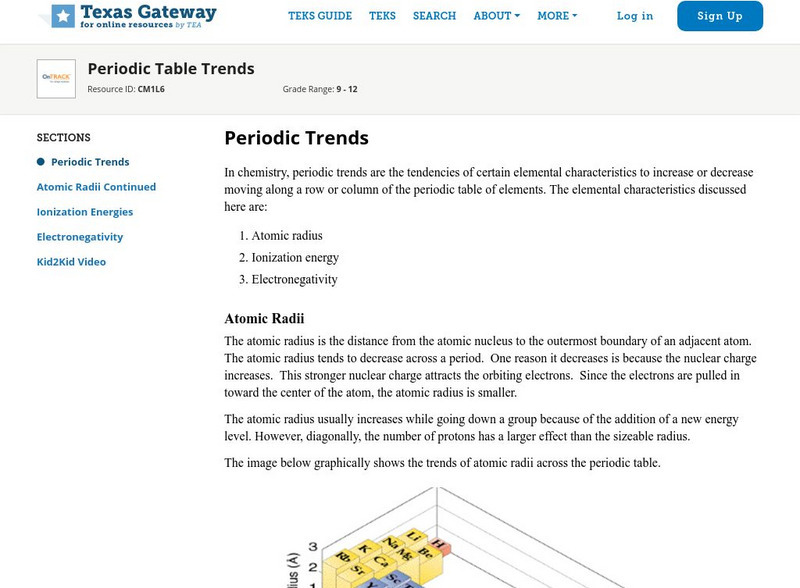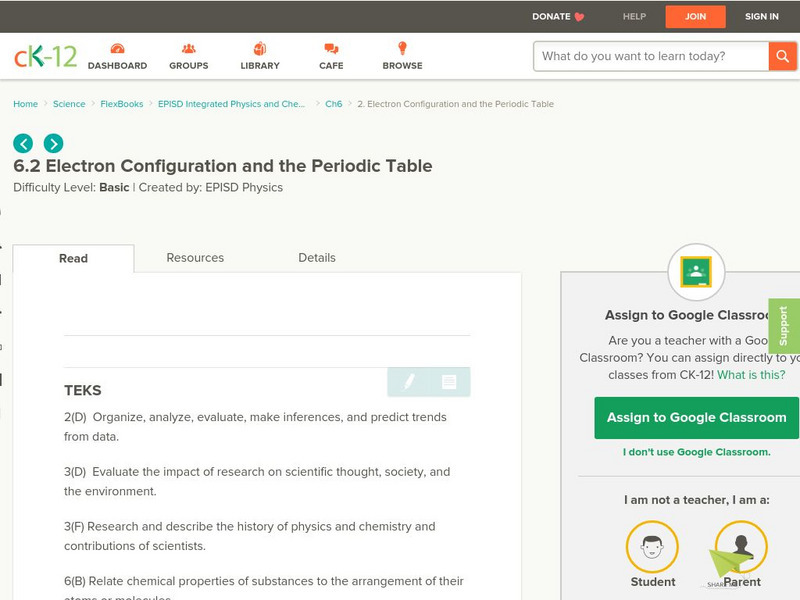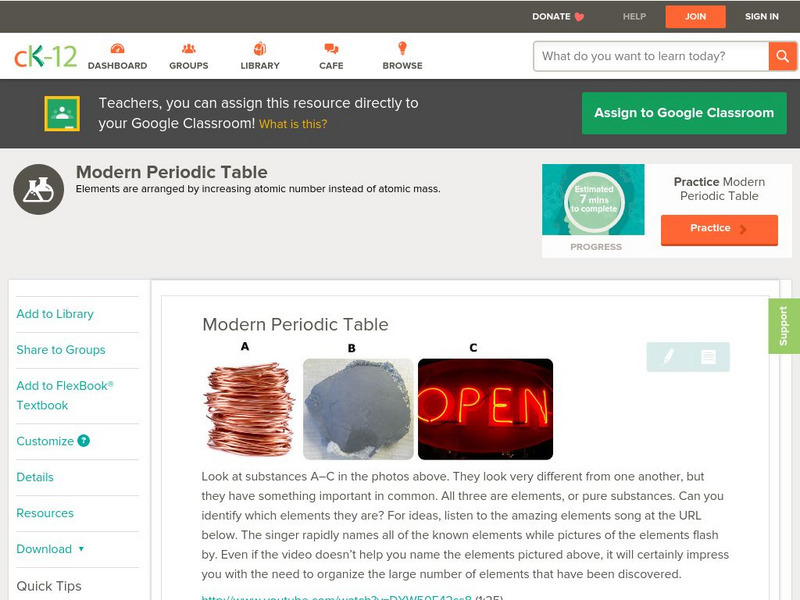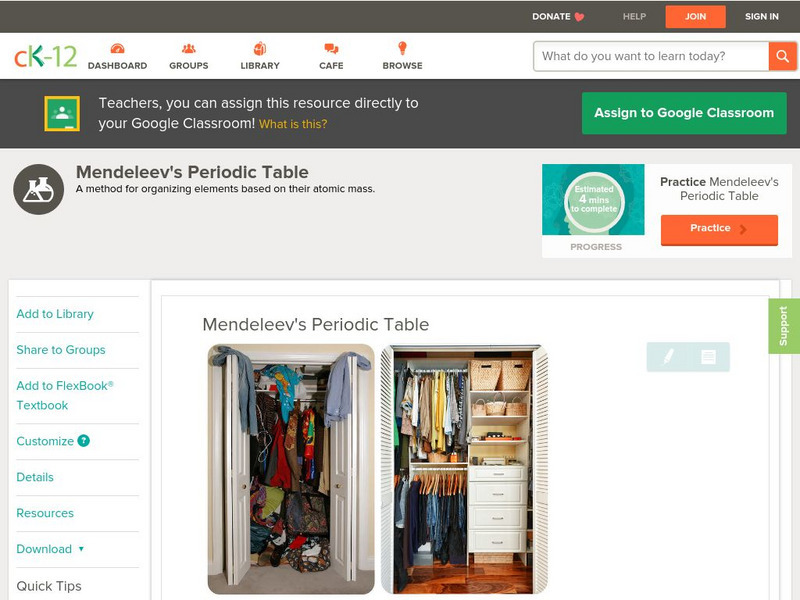Jefferson Lab
The Periodic Table of Elements
A study of the periodic table of elements doesn't have to be elementary! Deepen understanding of the building blocks of chemistry with an interactive periodic table. At first sight, the table looks like a standard reference page, but a...
National Science Teachers Association
Metals Metalloids Nonmetals
When physical science classes are becoming familiar with the periodic table of elements, you can use this set of printable cards to help them memorize some of the members of the metals, metalloids, and nonmetals groups. There are 24...
Super Teacher Tools
Classroom Jeopardy
Why not review for that chemistry test with a little healthy classroom competition? With a fun and interactive Jeopardy-style game, you can adjust the number of teams, keep track of scores, and even make your own test if the provided...
Columbus City Schools
Magnificent Mendeleev: An Elemental Tale
Discover how the periodic table tells the story of its elements. Learners begin by studying the makeup of several mixtures. Their analysis leads to a discussion of elements and the periodic table. As they dig deeper, they understand the...
K12 Reader
Elements & Atoms
Study matter in a new way with a cross-curricular assignment for language arts and math. Learners answer five reading comprehension questions after reading a few paragraphs about the periodic table, properties of elements, and how atoms...
Royal Society of Chemistry
Elements 1
The periodic table can be a little overwhelming to young scientists. Meet your class' worries head on by introducing the table in a game. Individuals test their knowledge of the names and symbols of common elements, then use deductive...
Aquarium of the Pacific
Lego Molecules
Young scientists construct an understanding of molecular compounds in this hands-on science lesson. Using LEGO® to model the atoms of different elements, students build molecules based on the chemical formulas of common compounds.
University of Georgia
Resumé of an Element
Class members use the provided worksheet to create a resume for one element from the periodic table. The activity teaches learners about all of the properties of elements and how to read the periodic table.
Royal Society of Chemistry
Vanadium
Introduce your chemistry scholars to the periodic table's Goddess of Beauty! Through an interactive that highlights the transition metal vanadium, learners discover the colors produced in solution as vanadium changes oxidation state....
NASA
Connecting Models and Critical Questions
Scholars use data to analyze and determine which sets of information need to be counted. They create a model to explain differences among chemical elements using graphs to prove concept mastery.
EngageNY
Basic Trigonometric Identities from Graphs
Have young mathematicians create new identities! They explore the even/odd, cofunction, and periodicity identities through an analysis of tables and graph. Next, learners discover the relationships while strengthening their...
West Contra Costa Unified School District
Key Features of Graphs
The key is ... After a day of instruction on key features of graphs, groups create a poster and presentation on the key features of their given function graph. The resource provides an extension activity of "telephone" using...
EngageNY
Graphing the Tangent Function
Help learners discover the unique characteristics of the tangent function. Working in teams, pupils create tables of values for different intervals of the tangent function. Through teamwork, they discover the periodicity, frequency, and...
Cave Creek Unified School District
Crusades and Culture in the Middle Ages
The Crusades sounds like a glamorous time period in the Middle Ages full of glory—but was it? Scholars find and review the truth of the Crusades' influence on the world through the resource. The study guides, separated individually by...
Texas Education Agency
Texas Gateway: Periodic Table Families
Given descriptions or specific element groups, students will use a Periodic Table to relate properties of chemical families to position on the table.
PBS
Pbs Learning Media: Periodic Table of the Elements
This interactive periodic table developed for Teachers' Domain provides detailed information about the chemical properties of elements and illustrates the electron configurations that determine those characteristics.
Texas Education Agency
Texas Gateway: Periodic Table Trends
Given descriptions, scenarios, or groups/series of elements, students will use the Periodic Table to relate the size of the atomic radii, electronegativity, and ionization energy of elements to their position on the chart. Students will...
Soft Schools
Soft Schools: Periodic Table Groups Quiz
Take an interactive quiz over the groups on the periodic table of elements. After completing the quiz, check your score, and then revisit any incorrect question for further review.
CK-12 Foundation
Ck 12: Electron Configuration and the Periodic Table
[Free Registration/Login may be required to access all resource tools.] In this learning module, students will explore how the form of the periodic table is related to electron configurations, which in turn influences chemical reactivity.
CK-12 Foundation
Ck 12: Chemistry: Modern Periodic Table
[Free Registration/Login may be required to access all resource tools.] Periods, groups and the classes of elements in the modern periodic table.
CK-12 Foundation
Ck 12: Physical Science: Mendeleev's Periodic Table
[Free Registration/Login may be required to access all resource tools.] Mendeleev's periodic table and the groups and periods.
Sophia Learning
Sophia: Periodic Table: Lesson 4
Explain how elements on the periodic table are arranged, and explain the relationships within each row and column. This lesson is 4 of 4 in the series titled "Periodic Table."
Scholastic
Scholastic: Study Jams! Science: Matter: Periodic Table
A video and a short quiz on the periodic table of elements and how it is organized.
BBC
Bbc: Gcse Bitesize: The Periodic Table
Elements in the same group in the periodic table have similar chemical properties. This is because their atoms have the same number of electrons in the highest occupied energy level. Group 1 elements are reactive metals called the alkali...























